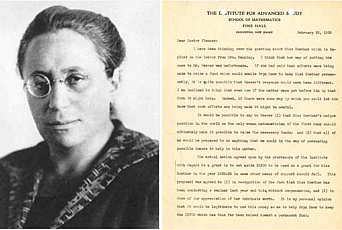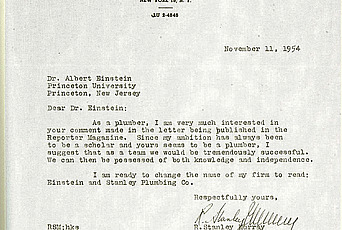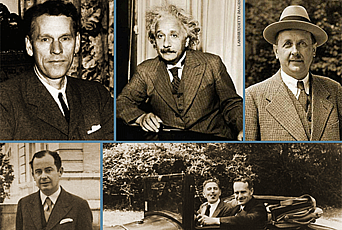The Institute’s Founding Ethos in Our Precarious Present

Sanctuary rites
The Institute for Advanced Study came into being at the most inauspicious of times. Founded in the early years of the Great Depression, it took shape during the buildup to the Second World War and under the growing shadow of authoritarian regimes. Its first Director Abraham Flexner published his manifesto on the “The Usefulness of Useless Knowledge” in October 1939, barely a month after the outbreak of hostilities in Europe. Surely this was a daunting moment to defend “the fearless and irresponsible thinker” and advocate for the free expression of knowledge and curiosity.
The very adversity of the era, however, also created opportunities for the fledgling institution, primarily in the form of sudden availability of renowned and newly mobile scholars from the upper echelons of the German university system. After expressing initial hesitation, Flexner followed the urging of influential faculty members, particularly the mathematician Oswald Veblen, in seeking to provide a haven for some of these new refugees, a sanctuary tradition continued by Director Frank Aydelotte, Flexner’s successor. In association with the Emergency Committee in Aid of Displaced Foreign Scholars (on which Veblen and Flexner served and whose name initially specified German rather than Foreign Scholars), the Rockefeller Foundation, and the Carnegie Foundation, IAS played a leading role in this farsighted, if ever elite, rescue effort.
We find ourselves today, nearly nine decades after the Institute’s founding in 1930, at another inauspicious juncture. Global political forces in power from Turkey to the United States are posing serious threats to the autonomy of scientific research and the mobility of researchers, undercutting two cardinal conditions for scientific progress. Walls, fences, bans, blocks, restrictions, cuts, and expulsions are slowly becoming run-of-the-mill terms for us to navigate in an increasingly precarious political landscape.
Travel restrictions involving pure accidents of birth, documented by passports from flagged countries, have prompted us to revisit today the Institute’s history not because we believe that history repeats itself. Rather, we seek to provide the IAS community with sketches of scholarly lives and scientific cultures, interrupted by nationalist forces of exclusion. That these lives and cultures managed to reconstitute themselves and enrich our common human heritage is thanks only to efforts to provide them with sanctuary.
The conversion of Abraham Flexner
At the end of January 1933, Adolf Hitler became chancellor of Germany. Over the next two months, the Nazi Party moved quickly to consolidate its power, expanding executive authority through emergency decrees following the Reichstag fire and swiftly moving into a formal dictatorship. An edict in April initiated a purge of civil servants who were of non-Aryan descent or exhibited suspect political sentiments. This law directly impacted German universities, and it had a particularly strong effect in the fields of mathematics and natural sciences, where Jews had enjoyed better prospects of pursuing a scholarly career. As a consequence, many of the country’s strongest intellectual centers lost leading figures in the space of just a few months, including the renowned Mathematical Institute at the University of Göttingen, home of David Hilbert, Richard Courant, Hermann Weyl, and Emmy Noether. This upheaval produced a sudden wave of refugee scholars seeking to emigrate and desperate to find positions elsewhere. It also coincided with the transition of IAS from a concept to an embodied institution, through the founding of the inaugural School of Mathematics.
The crisis of refugee scholars presented Flexner and Veblen with a challenging opportunity. The Institute had already pulled an extraordinary coup in recruiting Albert Einstein and John von Neumann shortly before Hitler’s coming to power. But how far should they continue in recruiting additional émigrés? Flexner initially expressed ambivalence on the topic, torn between a desire to live up to founding ideals and concern over the need to support and foster local talent. As he wrote to Veblen on March 27, 1933: "Mr. Bamberger and Mrs. Fuld were very anxious from the outset that no distinction should be made as respects race, religion, nationality, etc., and of course I am in thorough sympathy with their point of view, but on the other hand if we do not develop America, who is going to do it, and the question arises how much we ought to do for others and how much to make sure that civilization in America advances." On May 2, again responding to Veblen, he expanded on the same theme: "We are certainly in the devil of a fix. Unable to care for our own younger men, we are pressed by applications from foreign countries. It seems to me clear that we must in the first place endeavor to find work for those whom we have encouraged to train themselves in this country on the theory that, if they were worthy, there would be jobs waiting for them. Until we have done that, what else can we do? Our opportunities for making places for foreigners are therefore at the moment limited to a few outstanding personages such as Einstein and Weyl . . ."
For his part, Veblen pressed for a more active stance, not only advocating that the Institute do all it could, but also endorsing the establishment of a formal network to provide assistance to scholars in need. As he wrote to Flexner on May 5: “Some kind of a committee to raise funds for the purpose of enabling some of them to live and continue their scholarly work in the countries adjacent to Germany or elsewhere might be feasible. The existence of such a committee would in itself be an eloquent protest.” That same month, the Institute of International Education in New York City set up its Emergency Committee in Aid of Displaced German Scholars (later renamed to include all Foreign Scholars), headed by Edward R. Murrow, to assist scholars fleeing Europe. Veblen would join its board soon thereafter.
The crisis of refugee scholars presented Flexner and Veblen with a challenging opportunity. The Institute had already pulled an extraordinary coup in recruiting Albert Einstein and John von Neumann . . . but how far should they continue in recruiting additional refugees?
Over the course of the ensuing years, Flexner would undergo a conversion, becoming more deeply involved in assistance projects—he followed Veblen into the Emergency Committee—and increasingly willing to mobilize the Institute to this effect. In a 1938 letter to George Birkhoff at Harvard, he insisted that national origin should never stand in the way of higher goals. “Let us keep firmly in front of our eyes our real goal, namely the development of mathematics, not American mathematics or any other specific brand of mathematics, just simply mathematics. It can be developed only by having first-rate men in important posts, and every time an institution gets one first-rate man he creates opportunities for other first-rate men, and every such center that is developed stimulates some other institution to do likewise. Hitler has played into our hands and is still doing it like the mad man that he is. I am sorry for Germany. I am glad for the United States. I will undertake to get a position within a reasonable time for any really first-rate American mathematician, and I will also undertake simultaneously to do the same for any first-rate foreign mathematician whom Hitler may dismiss. The more the merrier.”
In his Director’s Report the following spring, Flexner even cast the matter as heralding a seismic change in the geography of knowledge: "We are living in an epoch-making time. The center of human culture is being shifted under our very eyes. Once it had its home in Athens. A few centuries later it had its home in Italy, a few centuries later in Paris, and thereafter also in Great Britain and Germany. It is now being unmistakably shifted to the United States. The scholars of Europe are refugees driven out of their own countries sometimes for political or religious reasons and sometimes because they are too unhappy and too distracted to pursue the work to which they are giving their lives. They have come to the Institute or have corresponded with the Institute literally by the hundreds. We cannot, of course, undertake either to give them places or to find them places, though we have done something substantial under both heads. Fifty years from now the historian looking backward will, if we act with courage and imagination, report that during our time the center of gravity in scholarship moved across the Atlantic Ocean to the United States. It is a grave responsibility which is thus being thrust upon us all.” From a vantage point almost eighty years later, Flexner’s claim seems more prophetic than hyperbolic. Although the transference in scientific work away from German and toward global English may have begun earlier, the center of gravity clearly shifted in the second half of the twentieth century. Germany’s leading share of Nobel Prizes plummeted after the war, even as the number of American laureates soared (one third of whom were foreign born).
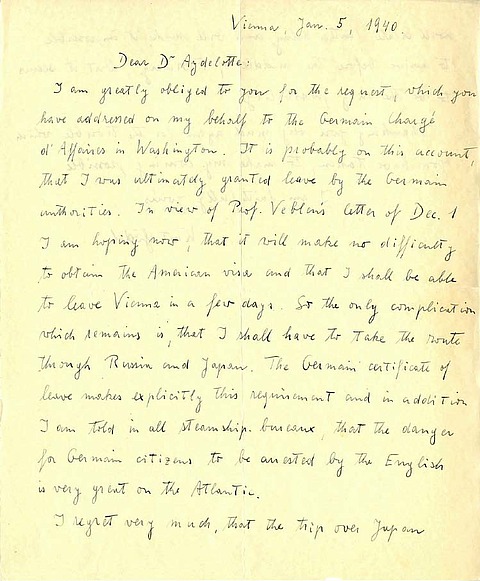
“A wall of bureaucratic measures”
The actual process of reaching the United States was far from simple for most would-be immigrants, who had to navigate not just an ocean, but also a maze of paperwork to obtain the requisite permission to exit and enter. To assist them, Flexner and Aydelotte used their extensive contacts and pulled strings as much as possible. When the mathematical logician Kurt Gödel found himself unable to leave Vienna in October 1939, Flexner contacted the chief of the visa division at the Department of State to plead on his behalf. Although Gödel had been legally admitted as a permanent resident earlier in the 1930s, he had returned to the annexed country that used to be Austria, and was facing difficulty getting authorization to return to the United States. “Is there anything that the State Department or the Consul General can do,” Flexner asked, “to suggest some helpful method of procedure?" The American authorities answered that the problem seemed to be with German authorities, and so Flexner’s successor Aydelotte contacted the German embassy in Washington, D.C. Eventually Gödel and his wife Adele were permitted to leave. By German directive they traveled east instead of west, avoiding British surveillance of the Atlantic by crossing Siberia and eventually getting to Japan in 1940, where they found a boat to San Francisco.
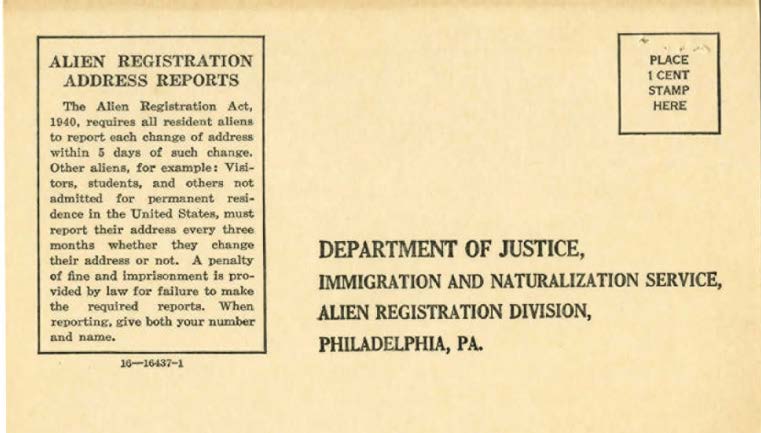
Even after refugees succeeded in reaching the United States, they needed to stay bureaucratically alert, and often required assistance. Under the Alien Registration Act of 1940, the U.S. Immigration and Naturalization Service collected fingerprints and required noncitizens to record all changes of address. Even local travel could necessitate permission, such that Gödel, once finally settled in Princeton, had to request permission to travel with his wife to visit a doctor in New York City in January 1942. They always went by train, Gödel assured the U.S. Attorney, and returned on the same day. Three weeks later, Aydelotte’s secretary sent a follow-up plea, noting, "If you could grant them this permission promptly it would be a great relief to them and would be very much appreciated.”
The IAS faced other hurdles in its attempts to assist refugee scholars, including the criteria established by the very bodies seeking to provide aid. The case of Ernst Kapp illustrates the poignant complications involved. In 1937, Kapp, an eminent classicist, lost his position in Hamburg due to his liberal beliefs and his wife’s classification as “non-Aryan.” Already in England for a visit to Oxford, Kapp managed to get himself to New York by 1939, and began desperately seeking a position. At IAS, the art historian Erwin Panofsky and Aydelotte sought to assist him, contacting possible means of support. After extensive efforts Kapp managed to find an instructorship at the H. Sophie Newcomb Memorial College for women at Tulane University in New Orleans, but it only paid $750 a year, not the $2,000 required to receive the necessary visa. The Oberlaender Trust offered an additional $650, and Panofsky wrote to the Emergency Committee to plead for the remainder. This last-minute success only brought a year’s reprieve, and more than two hundred applications later he still had nothing; classicists were not in demand. Moreover, he fell between categories for assistance. As Aydelotte discovered when trying to assist him, the New School’s University in Exile had no room for scholars who were already in the United States. Kapp returned to New York for a temporary editing project. At the end of 1940, Aydelotte noted that despite potential support from the Emergency Committee and others, scholars were lost without an institutional home: “All that Kapp needs is an appointment with some institution, so that the institution can make a request for these contributions. In addition, I think some of Kapp’s friends would, if necessary, put up small sums such as they could afford (from $10 to $25 a month each) to ensure a modest livelihood for him. Kapp is not eligible for Dr. Alvin Johnson’s scheme because he is already in this country. The fact is that if he does not get some help he will not be here long, for he is likely to starve to death. He is at the moment down almost to his last dollar.” Again, Kapp found last-minute rescue in the form of an unorthodox appointment at Columbia, partly subvented by the Emergency Committee.
The Institute’s most famous scholar in exile, Albert Einstein, underscored the unending hassles that hindered attempts to welcome foreign scholars in a letter he wrote to Eleanor Roosevelt on July 26, 1941: “A policy is now being pursued in the State Department which makes it all but impossible to give refuge in America to many worthy persons who are the victims of Fascist cruelty in Europe. Of course, this is not openly avowed by those responsible for it. The method which is being used, however, is to make immigration impossible by erecting a wall of bureaucratic measures alleged to be necessary to protect America against subversive, dangerous, elements.”
A call for vigilance
As we immersed ourselves in the thicket of correspondence at the heart of the Institute’s archives, the sense of urgency expressed by scholars like Flexner, Veblen, Aydelotte, Einstein, Kapp, and Noether resonated deeply. Their notes and exchanges, not to mention the Emergency Committee in Aid for Displaced Foreign Scholars that Flexner and Veblen served on, had an unsettling contemporary ring to them. This part of the Institute’s history testifies to the individual courage of these men and women who extended a helping hand and built institutional networks to provide sanctuary for displaced refugees. In doing so, they overcame the nationalist siege-mentality that sees foreigners, whether they are mathematicians or fruit pickers, as a threat to be warded off. An unintended consequence of their acts was the shifting of the center of intellectual research from Germany to the United States, enriching the country that gave them refuge. Their individual initiatives and collective institution-building endeavors provide us with much-needed exemplars of moral fortitude.
There is a darker side to this story. It only took a few months and one edict purging civil servants of non-Aryan descent or exhibiting suspect political sentiments in April 1933 to drain the German university of many of its brightest minds and its intellectual vigor. Of course, the contemporary political situation in the United States remains far from this extreme case. Nonetheless, knowledge of this history should serve as a call for vigilance in the face of policies such as travel bans and immigrant deportations, as well as attempts to curb scientific inquiry and cut funding to arts and humanities endowments that now threaten the autonomy of research and the pursuit of a dignified human life. Unfortunately, history suggests it takes much less time to destroy than to build. As it did in the 1930s, the Institute can play a leading symbolic role in our contemporary predicament.
References: (Unless otherwise noted, from the Shelby White and Leon Levy Archives Center, Institute for Advanced Study)
Letter from Flexner to Veblen, March 27, 1933 (Director’s Office: Faculty files: Box 32: Veblen, Oswald, 1933).
Letter from Flexner to Veblen, May 2, 1933 (ibid.).
Letter from Veblen to Flexner, May 5, 1933 (ibid.).
Letter from Flexner to George Birkhoff, Harvard University, September 1938 (Director’s Office: General files: Box 8: Birkhoff, George D.).
Letter from Flexner to Warren (Chief, Visa Division, Department of State), October 4, 1939 (Director’s Office: Faculty files: Box 14: Gödel, Kurt – Visa-Immigration).
Letter from Johnson (New School) to Aydelotte, September 23, 1940 (Director’s Office: General files: Box 34: Kapp, Ernst).
Letter from Aydelotte to Seelye (ECADFS), December 24, 1940 (ibid.).
Letter from Kurt Gödel to United States Attorney, Trenton, January 8, 1942 (Director’s Office: Faculty files: Box 14: Gödel, Kurt – Visa-Immigration).
Letter from Aydelotte's secretary to the same United States Attorney, January 29, 1942 (ibid.).
Board Minutes, Abraham Flexner, Director’s Report, May 22, 1939 (Board of Trustees records: Minutes: Box 4: Minutes of Regular Meeting).
Jon Bruner, “American Leadership in Science, Measured in Nobel Prizes,” Forbes, October 5, 2011: www.forbes.com/sites/jonbruner/2011/10/05/nobel-prizes-and-american-lea….
Michael Gordin, Scientific Babel: How Science Was Done Before and After Global English (Chicago: University of Chicago Press, 2015).
Hans Peter Obermayer, “Kurt von Fritz and Ernst Kapp at Columbia University: A Reconstruction According to the Files,” The Classical World 101: 2 (Winter 2008): 211–249.
Laura Smith Porter, “From Intellectual Sanctuary to Social Responsibility: The Founding of the Institute for Advanced Study, 1930–1933,” (Ph.D. diss., Princeton University, 1988), especially Chapter 5.
